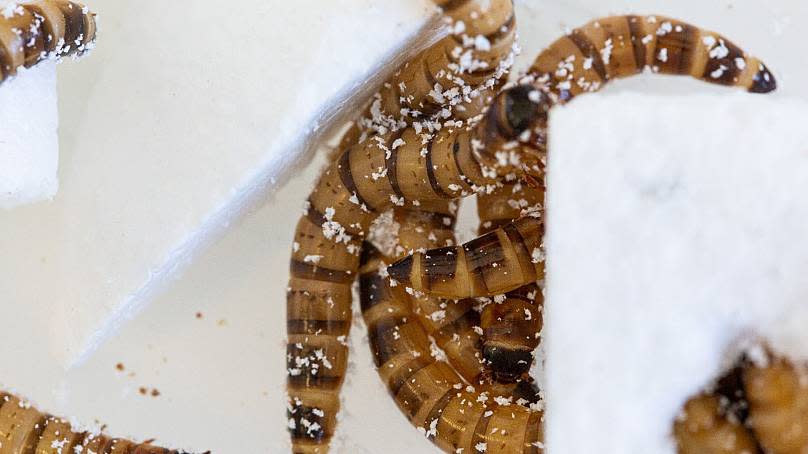Plastic pollution: This tiny worm can dissolve plastic bags with its drool

A tiny wax worm can dissolve plastic pollution with its saliva, new research has found.
Plastic can take up to 1000 years to decompose, clogging up landfill and polluting the ocean.
But climate campaigners have recruited an unlikely new ally in their fight to reduce this waste - wax worms, the moth larvae that infest beehives.
The worm’s saliva contains two enzymes that can degrade polyethylene, a tough material used in plastic bags and bottles.
According to Spanish researchers, one hour’s exposure to the worm’s saliva degrades the material as much as years of weathering.
The impetus for the study came in 2017 when a scientist - and amateur beekeeper - was cleaning out an infested hive.
The larvae had started eating holes in a plastic refuse bag.
“To the best of our knowledge, these enzymes (in the saliva) are the first animal enzymes with this capability, opening the way to potential solutions for plastic waste management through bio-recycling/up-cycling,” the research report - published in Nature this month - reads.
These stunning Central American lakes and beaches are now covered in plastic waste
This project is waging war on the plastic that poisons our rivers
How bad is plastic for the planet?
Humans have littered the entire planet with damaging plastic debris.
The hardy material takes millions of years to decompose. Of the 10 billion tonnes of plastic that have ever been created, a whopping 6 billion sits in landfill sites or pollute the environment.
This has a devastating impact on wildlife - more than 90 per cent of the world’s seabirds have plastic in their guts.
Recycling can help mitigate some of the worst effects of plastics. Yet a 2022 report by the Organisation for Economic Co-operation and Development (OECD) found that just 9 per cent of plastic is successfully recycled.
This is where the wax worms come in. They can help dissolve polyethylene, which accounts for roughly 30 per cent of plastic production worldwide.
Other eco innovations helping to reduce waste
Wax worms aren’t the only solution that scientists have come up with to combat our ever-growing plastic problem.
Plastic-munching superworms
From eating less meat to buying local ingredients, there are lots of ways to make environmentally friendly food choices. And according to a 2022 Australian study, certain types of worms can adopt an eco-diet too - but not in the way you might think.
Queensland scientists have discovered that the Zophobas morio - a type of beetle larvae commonly known as a superworm - can survive on polystyrene alone.
Over three weeks, the research team fed three groups of superworms different diets.
The worms on the plastic diet acted like “mini recycling plants,” lead author Dr Chris Rinke explains, destroying the plastic with their unique gut enzymes.
They even put on weight in the process.
“[The superworms] shred the polystyrene with their mouths and then fed it to the bacteria in their gut,” says Dr Rinke.
If scientists can work out how to grow the gut enzyme in a lab, they could use it to dissolve plastics on a mass scale, forming these byproducts into bioplastics.
“We can then look into how we can upscale this process to a level required for an entire recycling plant,” said Co-author of the research, PhD candidate Jiarui Sun.
Given that polystyrene accounts for around one-tenth of all non-fibrous plastics, this would be a significant breakthrough.

Plastic made from fish sperm
It might sound slightly fishy, but Chinese scientists have constructed an eco-friendly plastic from salmon sperm.
The researchers isolated two short strands of DNA from the sperm, binding them together with a chemical from vegetable oil.
From here the gel was moulded into different shapes and freeze-dried to remove the moisture, which makes it solidify. Scientists have successfully formed this gel into cups and plates - just maybe don’t think about where the crockery came from when you’re eating off it.
Turning plastic into ice cream
Plastic bottles can be converted into vanilla flavouring using heated bacteria, a 2021 study reveals.
By adding E.coli to plastic, scientists could make vanillin, a compound found in vanilla beans.
Given that people use more than 37,000 tonnes of vanilin per year, it’s a significant breakthrough - and proves that recycled plastic could find new life on the industrial chemical market.
Plastic ‘eco-bricks’
You don’t need a PhD in biochemistry to build an ‘eco brick.’ Last year, the ‘eco-brick’ trend - which involves filling plastic bottles with non-recyclable plastic and sending them off to be used in construction - went viral on TikTok.
When the ‘brick’ is full, it can be dropped off at a local Ecobrick Exchanges in England, US, and Wales - and used to make everything from furniture to garden walls. The group are always looking to start chapters in new countries.
Plastic-eating mushrooms
In 2012, students from Yale University discovered a rare species of mushroom - the Pestalotiopsis microspora - that can ‘eat’ plastic.
The fungi consumes polyurethane (a main ingredient in plastic products) breaking it down and converting it into organic matter.
The mushroom can also grow without oxygen - so could hypothetically spore at the bottom of landfill sites.

 Yahoo News
Yahoo News 

